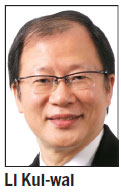HK's future might lie with Dapeng Peninsula
Updated: 2014-04-04 05:12
By Li Kui-wai(HK Edition)
|
|||||||||
According to a leak from official discussions, Hong Kong had considered acquiring a piece of land in the Nansha district of Guangzhou. This land could be turned into a special region for Hong Kong.
Effectively, the geographical size of Hong Kong would be enlarged, and the extra land could be used for different purposes. It was reported that the government had suggested that the Nansha land be used for the elderly and for public housing. Nonetheless, there needs to be more decisions about this from the central, provincial and city governments - as well as the Hong Kong government.
The Nansha district is seen as a good choice because it is adjacent to Hong Kong. It takes about one hour by ferry from Tsim Sha Tsui and can also be reached by land. It is situated at the tip of the Pearl River and numerous economic activities can be conducted there. It offers considerable potential as an industrial base, an educational hub and a center for commercial and residential activities. There really is no shortage of opportunities.
However, one has to be pragmatic and examine all the administrative realities and territorial possibilities. Firstly, the land of Nansha is connected to other parts of Guangdong. The first question is territorial - and the possibility of creating a "border". Secondly, how should we treat residents of Nansha? Even if we consider people with household registration as residents of Nansha, the land connection would make it difficult to draw a clear cut division on the number of Nansha residents. Furthermore, the Pearl River area is already quite developed and the standard of living is at a fairly high level. The idea of Nansha seems similar to nearby developments in Qianhai, where much has been made about building a "new Hong Kong". Developments there can potentially be more rapid than in other areas.

However, even though its acquisition by Hong Kong could be attractive to local residents, the choice of Nansha would be complicated. The idea of looking for nearby land to be included into the territory of Hong Kong is a noble one. A good alternative is Dapeng Peninsula, which is situated on the east of Hong Kong - east of Tung Ping Chau. One clear disadvantage is it is close to the Daya Bay Nuclear Power Plant. However, there are numerous advantages there. One is that it is a peninsula like Kowloon, and the "border" can be structured along the S30 Huishen Coastal Expressway. Together with natural divisions by the Jingxin Reservoir in the middle and the Forest Farm in the east, the establishment of a "border" should not be difficult. The peninsula can also be reached by ferry through Tung Peng Chau across Mirs Bay to the western side of the peninsula.
The number of residents in Dapeng Peninsula is surely not as large as Nansha. The number can easily be checked through the household registration system. In short, the peninsula is a raw or rather less-developed piece of land that would be useful to the future and long-term development of Hong Kong. Even if the residents in Dapeng Peninsula are given Hong Kong resident status, land in the peninsula can be used for various purposes. Basic infrastructure that can be built includes airports and shipping terminals. But development could cover financial trading and banking, industrial development, waste disposal, agriculture, marine farming and new residential destinations. Since Hong Kong law is to be introduced, the area would be manageable, as the sea surrounding it is easier to define than land connections in Nansha.
One can think of "twin peninsula" development, with the abundant supply of new land to Hong Kong. Much new investment would be attracted to it, and population congestion in Hong Kong could be eased.
With the hypothetical acquisition of Dapeng Peninsula, economic development in Hong Kong would then become "two-sided". The western side would deal with development along the Pearl River region - competing with Shenzhen, Macao and Guangzhou. Development on the eastern side would be less competitive, as the pace of development in the peninsula would be managed and funded by Hong Kong. This would offer a much greater degree of flexibility in deciding the use of land resources in Dapeng Peninsula.
The establishment of the "border" would be similar to that currently practiced with Shenzhen. Other than the existing S30 expressway that connects Shenzhen with Dapeng Peninsula, some border checkpoints could be arranged. An entirely new expressway could be built to serve as a border between Hong Kong and Shenzhen.
If the Hong Kong government has a vision for the future of Hong Kong, securing more land from Guangdong with the permission of the central government would provide more development opportunities. In a few decades, the Dapeng Peninsula would become a second Hong Kong.
It is feasible to conduct a study on the Dapeng Peninsula to see how it could be turned into "Hong Kong land" economically, geographically, legally, administratively and financially. It could also be the responsibility of Hong Kong to develop the peninsula. Bonds could be issued to help finance its long-term development.
The late paramount leader Deng Xiaoping once remarked that the post-1997 Hong Kong economy should outperform the pre-1997 one. Such a remark showed his long-term vision. Given the pragmatic economic system of Hong Kong, easing the city's land shortage would produce tremendous opportunities. Dapeng Peninsula seems to provide a ready-made answer.
The author is associate professor of the Department of Economics and Finance at City University of Hong Kong.
(HK Edition 04/04/2014 page9)